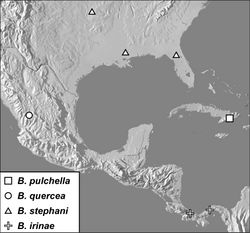Baconia quercea
| Notice: | This page is derived from the original publication listed below, whose author(s) should always be credited. Further contributors may edit and improve the content of this page and, consequently, need to be credited as well (see page history). Any assessment of factual correctness requires a careful review of the original article as well as of subsequent contributions.
If you are uncertain whether your planned contribution is correct or not, we suggest that you use the associated discussion page instead of editing the page directly. This page should be cited as follows (rationale):
Citation formats to copy and paste
BibTeX: @article{Caterino2013ZooKeys343, RIS/ Endnote: TY - JOUR Wikipedia/ Citizendium: <ref name="Caterino2013ZooKeys343">{{Citation See also the citation download page at the journal. |
Ordo: Coleoptera
Familia: Histeridae
Genus: Baconia
Name
Baconia quercea Caterino & Tishechkin, 2013 sp. n. – Wikispecies link – ZooBank link – Pensoft Profile
Type locality
MEXICO: Zacatecas: 13 mi W Milpillas [23.06°N, 103.88°W].
Type material. Holotype male: “Milpillas (13 mi. W), Zacat., MEXICO 9–12 July 1954 alt. 8400 ft.” / “on oak stump” / “R.H. Brewer leg. Field No. 1352” / “FMNH-INS 0000069304” (FMNH).
Diagnostic description
Length: 1.8mm, width: 1.4mm; body elongate oval, moderately convex, glabrous; color rufopiceous, with blue-bronze metallic tinge, particularly on elytra; head with frons moderately convex, ground punctation fine, sparse, with few coarser punctures near dorsolateral corners, frontal stria present along inner edge of eye, absent across front, supraorbital stria present, connected to sides of frontal stria; antennal scape short, clubs missing from type; epistoma faintly emarginate apically; labrum about 4×wider than long, apical margin shallowly emarginate; mandibles short, each with acute basal tooth; pronotum with sides weakly convergent from base, lateral marginal stria continuous with complete anterior marginal stria, lateral submarginal stria complete, pronotal disk weakly depressed in anterolateral corners, ground punctation fine, very sparse, with coarser secondary punctures sparsely impressed over most of disk, very slightly larger toward prescutellar area; elytra with two epipleural striae, outer subhumeral stria absent, fine fragment of inner subhumeral stria present at base, dorsal striae 1–4 complete to base, weakly bent mediad in anterior one-third, progressively more abbreviated from apex, base of 4th stria weakly arched mediad, 5th stria slightly abbreviated from base, more strongly so from from apex, sutural stria present only as short fragment just behind middle, elytral disk with scattered secondary punctures in apical one-third, extending further anterad toward middle; prosternal keel moderately broad, distinctly emarginate at base, with more or less complete carinal striae converging from base, subparallel in anterior half; prosternal lobe about two-thirds keel length, apical margin bluntly rounded, with marginal stria present only at middle; mesoventrite weakly produced at middle, with marginal stria interrupted for width of prosternal keel; mesometaventral stria strongly and broadly arched forward, continuous laterally with inner lateral metaventral stria, which extends toward inner corner of metacoxa, outer lateral metaventral stria very short, oblique; metaventral disk moderately coarsely punctate at sides, impunctate at middle; abdominal ventrite 1 with single, complete inner lateral stria, lacking secondary punctures on middle portion of disk, ventrites 2–5 with fine punctures at sides, becoming more sparsely punctate across middle; protibiae missing from type; mesotibia with two marginal spines; outer metatibial margin smooth; propygidium lacking basal stria, with fine ground punctation and slightly coarser, ocellate punctures uniformly separated by just more than their diameters, propygidial gland openings inconspicuous; pygidium with sparse ground punctation becoming slightly denser apically, with small secondary punctures only in basal half. Male genitalia (Figs 39D, F–H, K–L): T8 broad, sides rounded in basal two-thirds, obliquely angulate to apex, basal emargination narrowly arcuate, ventrolateral apodemes with inner apices separated by about three-fourths T8 width, projecting beneath beyond ventral midpoint, obsolete apically, apical margin narrowly emarginate; S8 very short, halves fused along midline, basal emargination shallowly sinuate, basal apodemes narrow, corners obliquely subtruncate, sides slightly narrowed toward apex, apical margin nearly truncate, projecting slightly at corners of narrow median emargination, bearing a moderately dense fringe of apical setae; T9 with short, slightly attenuate basal apodemes, halves separated dorsally, ventrolateral apodemes well-developed, acutely recurved proximad beneath, apices of T9 narrowly rounded, with 1–2 subapical setae on each side; T10 entire; S9 with stem narrow, about half total length, with fine median keel, head abruptly widened, sides subparallel to apex, apices acute, apical emargination broad; tegmen with sides weakly convergent in about basal two-thirds, more strongly convergent to apex, apices narrowly rounded, apical half of tegmen weakly curved ventrad; median lobe about one-fourth tegmen length; basal piece nearly one-third tegmen length.
Remarks
This species is most similar and closely related to Baconia aeneomicans and Baconia pulchella, sharing their relatively well developed frontal stria at the sides, and the arched mesometaventral stria displacing the marginal mesoventral stria. It is also weakly metallic in coloration (Fig. 38E), though under dim light it may not be distinct. Externally it lacks the 1st abdominal ventrite punctures that Baconia aeneomicans shows, and has quite distinct male genitalia, with the apices of the 8th sternite broad and subtruncate, rather than narrow and produced. There is a substantial gap between the only known locality for this species, in western Zacatecas, and the nearest localities for Baconia aeneomicans, in eastern Texas. Intervening localities may well bridge much of the morphological gap between the two species.
Etymology
This species is named to recognize the association of the only known specimen with oak, or Quercus.
Original Description
- Caterino, M; Tishechkin, A; 2013: A systematic revision of Baconia Lewis (Coleoptera, Histeridae, Exosternini) ZooKeys, 343: 1-297. doi
Images
|


